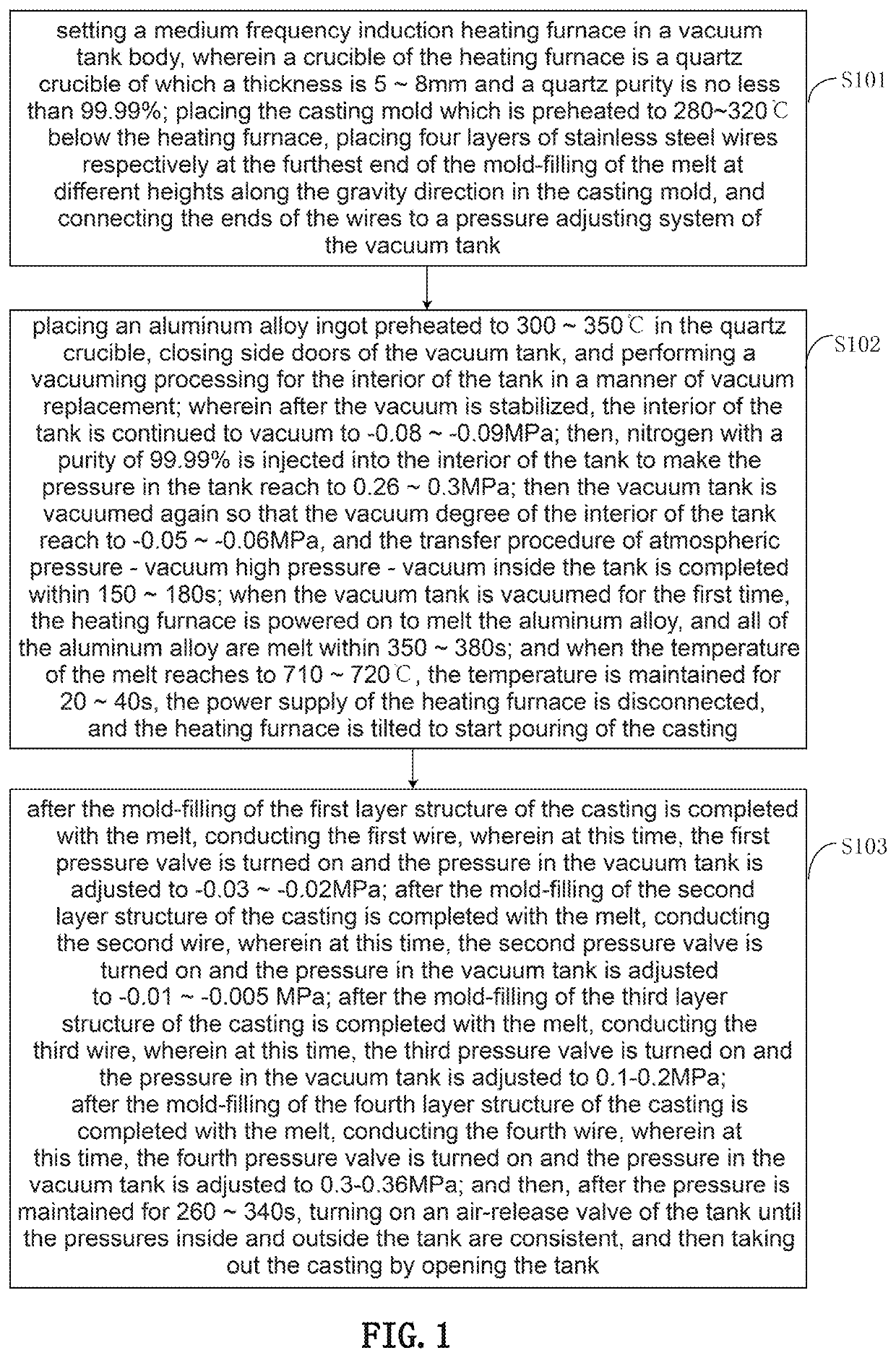Method for vacuum smelting and variable pressure solidification forming aluminum alloy piece with ultra-thin wall and high gas tightness
a technology of vacuum smelting and variable pressure solidification, which is applied in the field of aluminum alloy manufacturing, can solve the problems of patent application not performing improvement and control on smelting time, high mold-filling, and difficulty in prior art to ensure product quality of ultra-thin-walled duct products requiring high cleanliness, etc., and achieves high air tightness, avoids the cost of smelting protection, and high purity argon
- Summary
- Abstract
- Description
- Claims
- Application Information
AI Technical Summary
Benefits of technology
Problems solved by technology
Method used
Image
Examples
first embodiment
ZL101A Aluminum Alloy
[0046]1. A medium frequency induction heating furnace is set in a vacuum tank body, and a quartz crucible of which the thickness is 5 mm is used as a crucible of the heating furnace and a quartz purity is no less than 99.99%; the casting mold which is preheated to 305° C. is placed below the heating furnace, four layers of stainless steel wires are respectively placed at the furthest end positions of the mold-filling of the melt at different heights along the gravity is direction in the casting mold, and the ends of the wires are connected to a pressure adjusting system of the vacuum tank.
[0047]2. An aluminum alloy ingot preheated to 300° C. is placed in the quartz crucible, side doors of the vacuum tank is closed, and a vacuuming processing is performed for the interior of the tank in a manner of vacuum replacement; after the vacuum is stabilized, the interior of the tank is continued to vacuum to −0.09 MPa; then, nitrogen with a purity of 99.99% is injected in...
second embodiment
L114A Aluminum Alloy
[0050]1. A medium frequency induction heating furnace is set in a vacuum tank body, and a quartz crucible of which a thickness is 7 mm is used as a crucible of the heating furnace and a quartz purity is no less than 99.99%; the casting mold which is preheated to 280° C. is placed below the heating furnace, four layers of stainless steel wires are respectively placed at the furthest end positions of the mold-filling of the melt at different heights along the gravity direction in the casting mold, and the ends of the wires are connected to a pressure adjusting system of the vacuum tank.
[0051]2. An aluminum alloy ingot preheated to 332° C. is placed in the quartz crucible, side doors of the vacuum tank is closed, and a vacuuming processing is performed for the interior of the tank in a manner of vacuum replacement; after the vacuum is stabilized, the interior of the tank is continued to vacuum to −0.08 MPa; then, nitrogen with a purity of 99.99% is injected into the...
third embodiment
ZL205A Aluminum Alloy
[0054]1. A medium frequency induction heating furnace is set in a vacuum tank body, and a quartz crucible of which a thickness is 8mm is used as a crucible is of the heating furnace and a quartz purity is no less than 99.992%; the casting mold which is preheated to 320° C. is placed below the heating furnace, four layers of stainless steel wires are respectively placed at the furthest end positions of the mold-filling with the melt at different heights along the gravity direction in the casting mold, and the ends of the wires are connected to a pressure adjusting system of the vacuum tank.
[0055]2. An aluminum alloy ingot preheated to 350° C. is placed in the quartz crucible, side doors of the vacuum tank is closed, and a vacuuming processing is performed for the interior of the tank in a manner of vacuum replacement; after the vacuum is stabilized, the interior of the tank is continued to vacuum to −0.086 MPa; then, nitrogen with a purity of 99.99% is injected i...
PUM
| Property | Measurement | Unit |
|---|---|---|
| thickness | aaaaa | aaaaa |
| temperature | aaaaa | aaaaa |
| density | aaaaa | aaaaa |
Abstract
Description
Claims
Application Information
 Login to View More
Login to View More - R&D
- Intellectual Property
- Life Sciences
- Materials
- Tech Scout
- Unparalleled Data Quality
- Higher Quality Content
- 60% Fewer Hallucinations
Browse by: Latest US Patents, China's latest patents, Technical Efficacy Thesaurus, Application Domain, Technology Topic, Popular Technical Reports.
© 2025 PatSnap. All rights reserved.Legal|Privacy policy|Modern Slavery Act Transparency Statement|Sitemap|About US| Contact US: help@patsnap.com


